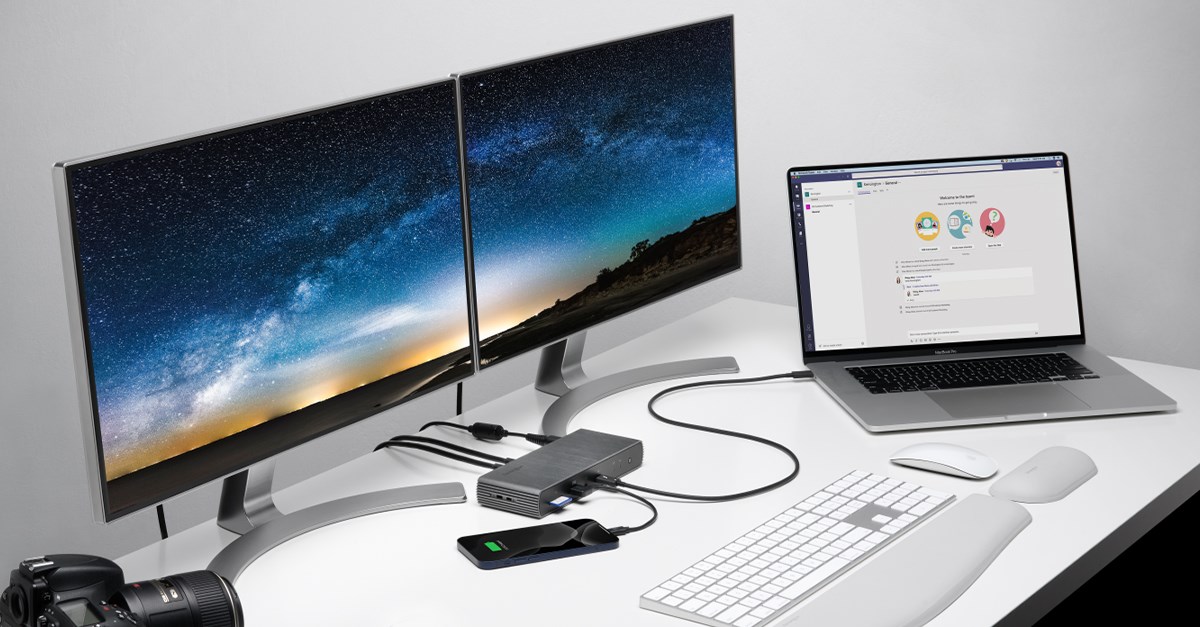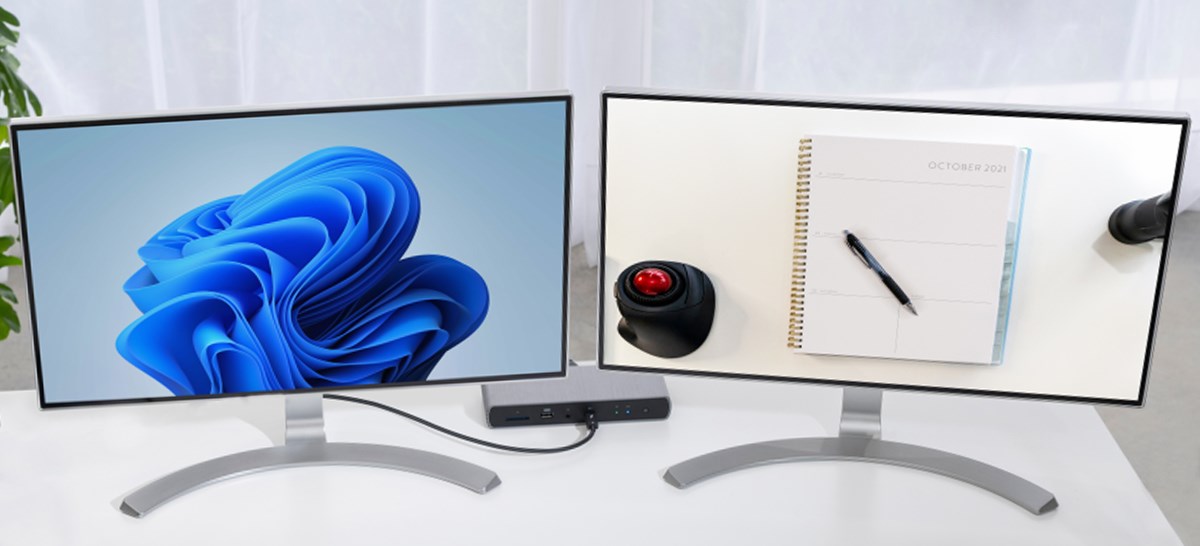
Animators, graphic designers, and visual professionals who live for high performance laptops with stunning displays are experiencing game-changing benefits with the Apple M1/M2/M3 chip. The M1/M2/M3 is Apple Inc.’s second System on a Chip (Soc), developed solely for use in Macs, and it marks its transition away from the Intel® chips that had been used in Macs for over 15 years. If you’ve made the investment in a newer 14” or 16” MacBook Pro with an M1/M2/M3 Pro or M1/M2/M3 Max chip or have jumped up to the Mac Studio with the M1/M2 Ultra chip, you’re already experiencing the impressive speed and efficiency of a single chip—and are probably ready to take advantage of the stunning external display capabilities available to you. While MacBooks with M1/M2/M3 base chipsets natively support only one monitor, here is Kensington's solution offering support for multiple displays. The SD4790P can even support up to three 4K displays for your MacBook.
Where Should You Start when Connecting Multiple Displays to Your MacBook Pro or Mac Studio?
While the M1/M2/M3 chips vary in terms of graphics, with the M1/M2/M3 Pro providing up to 16 GPU, the M1/M2/M3 Max providing up to 32 cores, and the M1/M2 Ultra providing up to 64, each of them provides the opportunity for multiple high-resolution screens and enhanced visual productivity.
A Thunderbolt™ 4 docking station is an excellent place to start if you want to maximize the display capabilities of your MacBook Pro or Mac Studio since it can bypass the chipset power and transfer the display to multiple high resolution monitors. Thunderbolt 4 docks support Dual 6K @ 60Hz, Quad 4K @ 60Hz—and up to five external displays if you’re using one with a Mac Studio with M1/M2 Ultra.
How Do I Set Up Multiple Monitors on a MacBook Pro with M1/M2/M3 Pro?
A MacBook Pro with M1/M2/M3 Pro can accommodate up to two external displays using either a Thunderbolt™ 4 docking station or by connecting the monitors directly to the MacBook Pro using the Thunderbolt 4 and HDMI® ports. The M1/M2/M3 Pro chip will support up to two external displays with up to 6K resolution @ 60Hz.
How Can I Set Up Four Monitors on a MacBook Pro with M1/M2/M3 Max?
A MacBook Pro with M1/M2/M3 Max can support up to four external 4K displays @ 60Hz—yes, Quad 4K @ 60Hz. This setup uses a Thunderbolt™ 4 docking station, such as the SD5700T or SD5780T, for two of the displays, plus two direct connections via the Thunderbolt 4 (USB-C®) and HDMI® ports on your MacBook Pro. As usual, Apple keeps the connection process simple.
What Else Should I Know About Setting up Dual 6K or Quad 4K with my MacBook Pro?
It’s important to keep a few details in mind when evaluating your display setup:
- The display setups mentioned here are for MacBook Pro’s using M1/M2/M3 Pro or M1/M2/M3 Max chips.
- Both the monitor, the Thunderbolt™ 4 docking station, and the MacBook Pro must support DSC 1.2 and DP 1.4 HBR3.
- A common issue is that the MacBook Pro and Thunderbolt 4 docking station will support DSC 1.2 and DP 1.4 HBR3, but the monitors only support DSC 1.1 or older. This will cause a reduction in resolution from 6K to 4K. For example, the LG UltraFine™ 5K does not support DSC, so even with two of these monitors they are not capable of Dual 4K display. Therefore, the LG UltraFine 5K will work best as a single 5K display.
- When choosing monitors, look for support of DSC 1.2 and DP 1.4 HBR3. Then you can make sure your MacBook Pro, docking station, and monitor(s) all have the same DSC 1.2 and DP 1.4 HBR3 version to deliver dual 6K @ 60 Hz.
- If you need multiple monitor support for your M1/M2/M3 MacBook that only supports a single display, you can overcome these limitations with docking stations and video adapters that enable you to set up multiple displays. Kensington has you covered with a range of industry-leading solutions for two monitor displays in extended mode.

How Can I Set Up Multiple Monitors on a Mac Studio with M1/M2 Ultra?
The Mac Studio with M1/M2 Ultra can support up to five external displays. Technically, you can direct connect all five monitors to the Mac Studio. However, if you use a Thunderbolt™ 4 docking station, such as the SD5780T, to handle two of the five, you’ll have access to more DisplayPort monitor ports from the front of your desk. The SD5780T comes with 11 ports of connectivity, including 3 Thunderbolt 4 ports, four USB-A 3.2 Gen2 (10Gbps) ports (one 5V/1.5A charging port on the front), one HDMI® 2.1 port, one 2.5Gbps Ethernet port; one audio combo jack, and one UHS-II SD 4.0 card reader.
What’s Next?
If you have a MacBook Pro with an M1/M2/M3 Pro or M1/M2/M3 Max chip or a Mac Studio with the M1/M2 Ultra chip, a Thunderbolt™ 4 docking station is an excellent accessory for helping you get the most from your Mac. From extending your display capabilities to providing transfer speeds up to 40Gbps to providing high-res audio for Thunderbolt 4 host devices, they are impressive productivity enhancers for professionals who want speed and next-gen visuals. It will also help you maintain a tidier desktop—for that clean and simple Apple appeal.
As new technology emerges, Kensington will continue to innovate and provide solutions that help professionals get the most from their workspace investments.
![]()
Image Title: Thunderbolt™ 3 or Thunderbolt™ 4 – Maximum Display Resolutions (Apple Silicon)
The image is divided into four sections based on the type of Apple Silicon chip and their capabilities to display single, dual, or quad displays in 4K or 6K resolution.
First Section: Apple M1, M2 and M3 Chip
This section describes how how M1, M2 and M3 MacBook Air or MacBook Pro natively support only one external monitor, which can be a single 4K resolution at 60Hz. Please note that for more than one external display, you will need a Kensington DisplayLink Docking Station. To connect the MacBook to one external monitor, use a Kensington Thunderbolt™ 3 or Thunderbolt™ 4 dock. The dock should be connected to the laptop on one end and the monitor screen on the other end using a suitable video cable. The MacBook screen (display A) and the external monitor (display B) can be shown in extended mode, meaning that the MacBook laptop screen and the external monitor screen can each show their independent displays.
Second Section: Apple M1, M2 and M3 Pro Chip
This section describes that 14” or 16” MacBook Pro with these chipsets can support two external monitors, which can be Dual 4K or 6K @ 60Hz in resolution. For 6K resolution, it is required to have DSC enabled on the laptop and monitor. To connect the MacBook Pro 14” or 16” to two external monitors, use a Kensington Thunderbolt™ 3 or Thunderbolt™ 4 dock. The dock should be connected to the laptop on one end and the two monitor screens on the other end using suitable video cables. The MacBook Pro screen (display A), one external monitor (display B), and the second external monitor (display C) can be shown in extended mode, meaning that the MacBook Pro laptop screen and the two external monitors screen can each show their independent displays.
Third Section: Apple M1, M2 and M3 Max Chip
This section describes that 14” or 16” MacBook Pro with these chipsets can also support two external monitors, which can be Dual 4K or 6K @ 60Hz in resolution. For 6K resolution, it is required to have DSC enabled on the laptop and monitor. To connect the MacBook Pro 14” or 16” to two external monitors, use a Kensington Thunderbolt™ 3 or Thunderbolt™ 4 dock. The dock should be connected to the laptop on one end and the two monitor screens on the other end using suitable video cables. The MacBook Pro screen (display A), one external monitor (display B), and the second external monitor (display C) can be shown in extended mode, meaning that the MacBook Pro laptop screen and the two external monitors screen can each show their independent displays.
Fourth Section: Apple M1 Max Chip and Apple M2 Max Chip to Achieve Quad Displays in 4K @ 60Hz
This section describes how to achieve quad displays in 4K @ 60Hz using a Thunderbolt™ 4 docking station, such as the SD5700T or SD5780T, for two of the displays connected from the docking station, plus two direct connections via the Thunderbolt 4 (USB-C®) and HDMI® ports on your 14” or 16” MacBook Pro. The laptop screen (display A) plus four external monitors labelled as B, C, D, and E can all show their independent displays in extended mode.
Disclaimers:
The first disclaimer pertains to dual 6K @ 60Hz and states that the Thunderbolt™ 4 Dock supports up to Dual 6K @ 60Hz with DSC enabled. Apple M1/M2 Pro, M1/M2 Max & M1 Ultra support DSC 1.2 & DP1.4 HBR3. The second disclaimer pertains to Quad 4K and states that the Mac Studio with M1 Ultra can support up to five external displays when two of the five displays are connected to a Thunderbolt 4 dock. (Note: Monitors and host devices must support the same DSC 1.2 and DP 1.4 HBR3.)
Learn more about Kensington’s Thunderbolt™ 4 docking stations